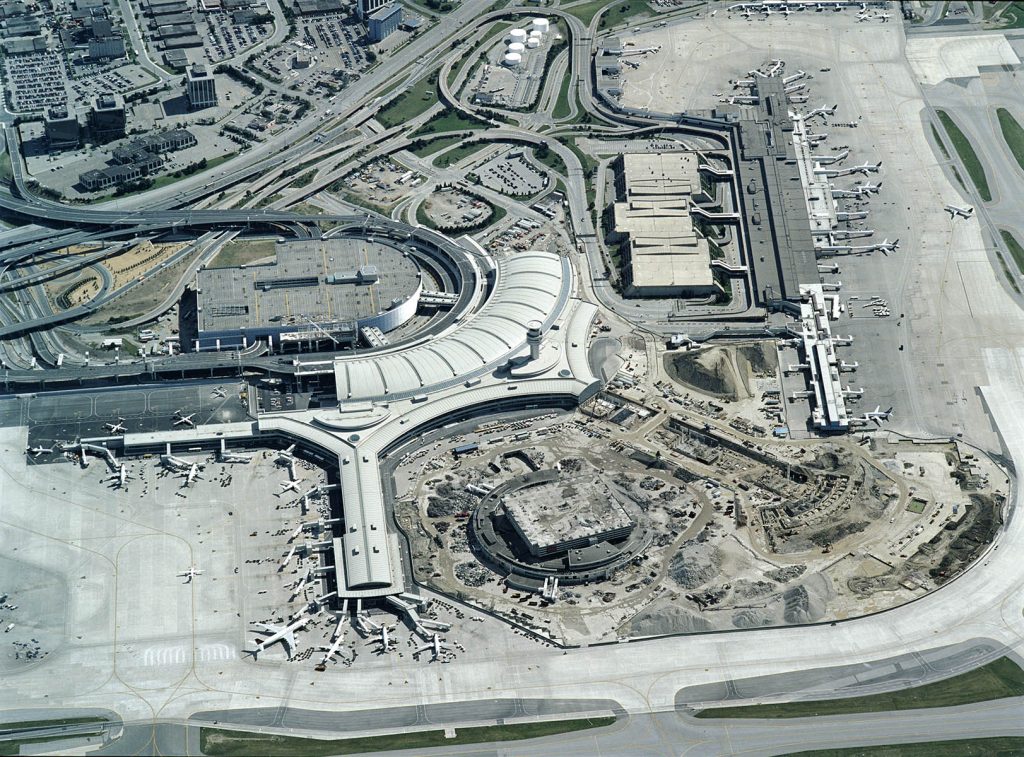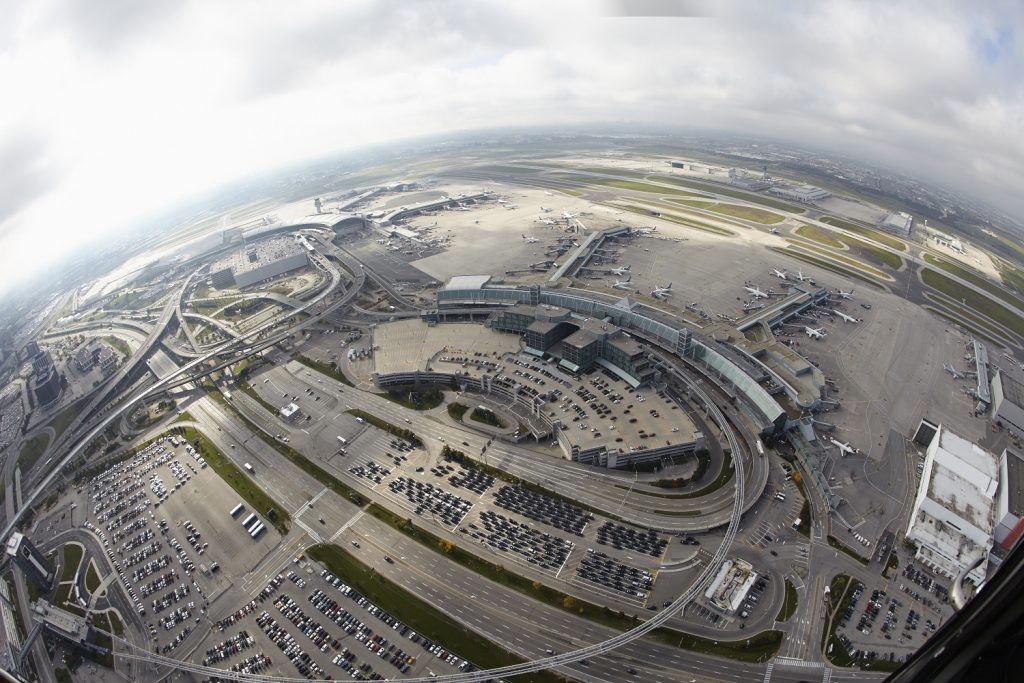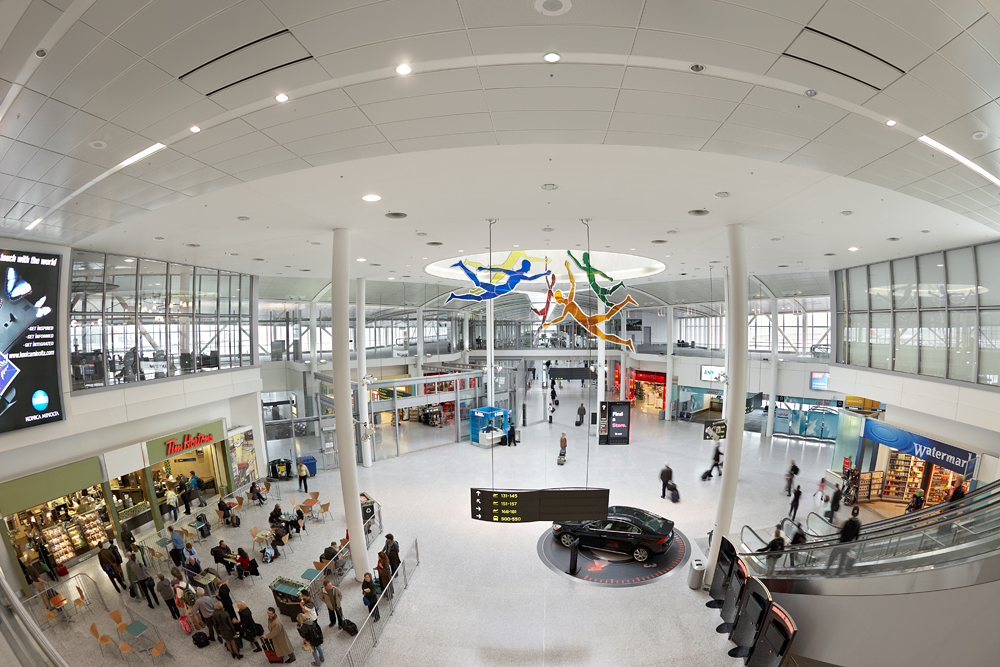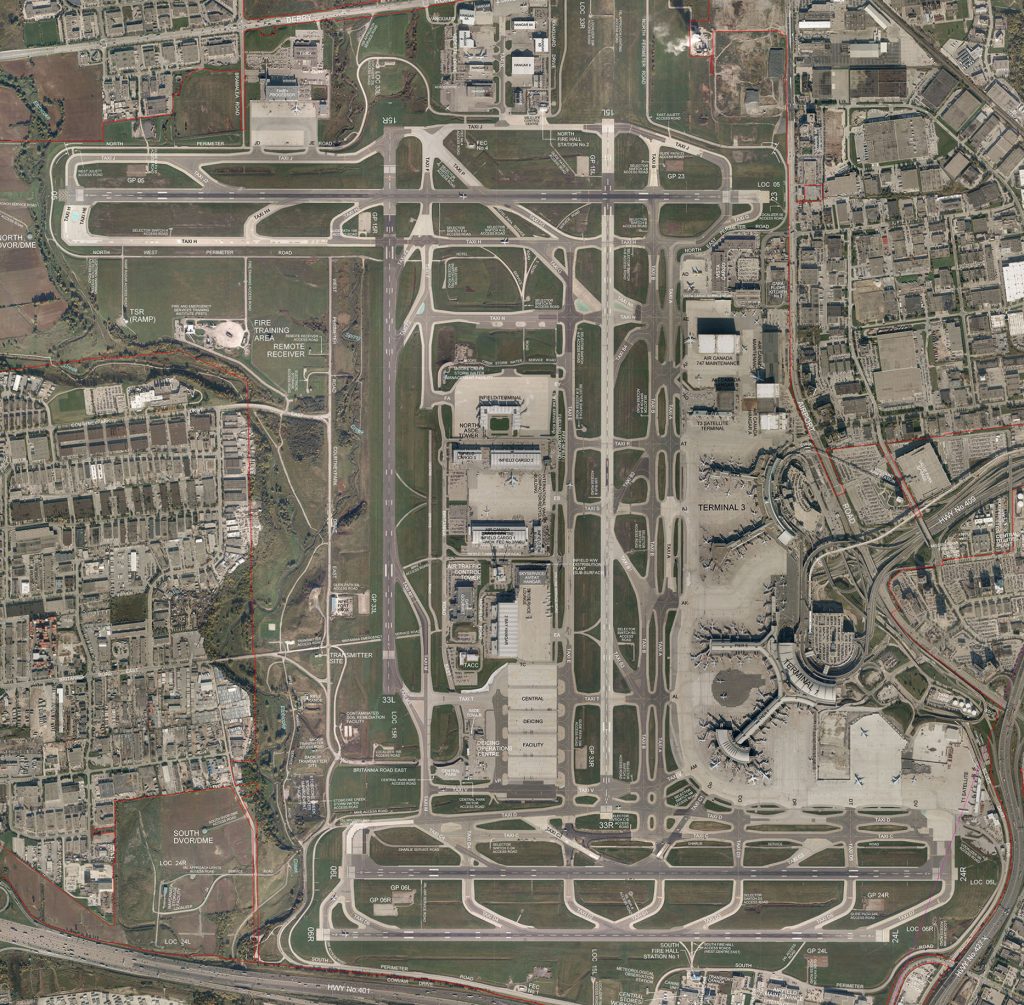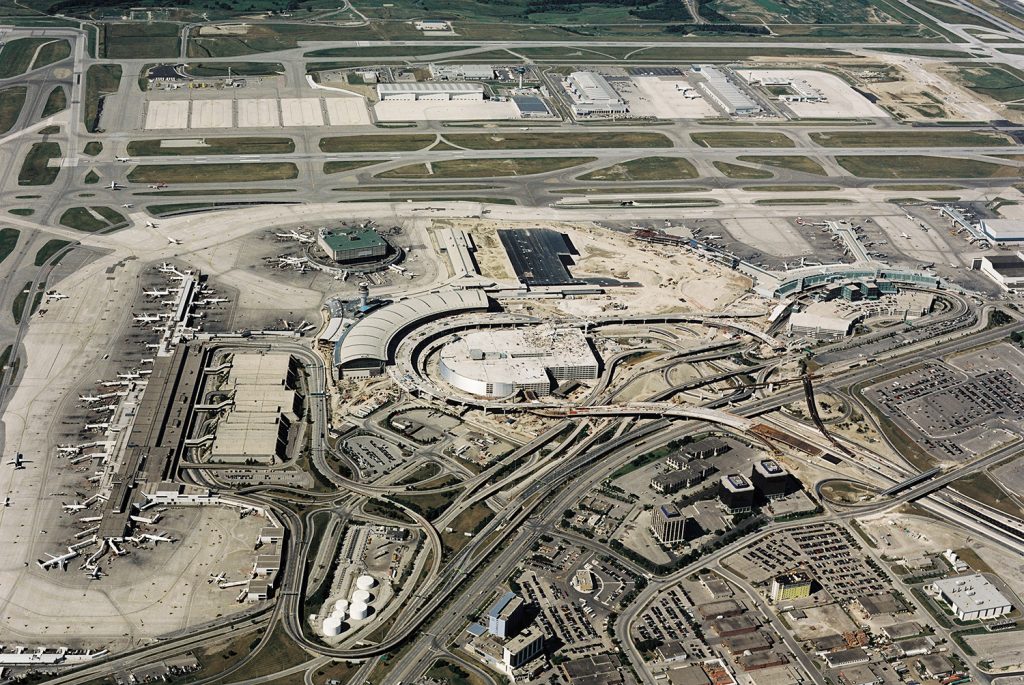
August 2002 – YYZ’s New Terminal 1 is under construction, with the completed Infield Complex in the background.
Photo: Air Canada
Written for Airwaysmag.com/Airchive.com
Link to Part One of the story. we looked at Toronto-Pearson International Airport (YYZ) from its first flights in 1939 to the establishment of the Great Toronto Airports Authority (GTAA) in the mid-1990s.
In 1995, to meet YYZ’s needs through to 2030, the GTAA proposed to replace YYZ’s Terminal 1-Aeroquay and Terminal 2, home of Air Canada, with a new Terminal 1. The logistical and operational challenges were formidable. All airline and airport operations had to be maintained while demolition of existing obsolete infrastructure occurred and new construction began. Not only was a new terminal planned, but 2 new runways, a massive infield operational and cargo area, a specialized de-icing bay and related taxiways and roadways were to be built and integrated into YYZ’s operation.
The pace of construction and operational change at YYZ from the mid-1990s until 2007 was remarkable. In 1997, a new parallel cross-wind Runway 15R/33L became operational, along with the first phase of what would become the world’s largest aircraft de-icing facility. The de-icing bay is located away from the terminals’ apron areas and close to the departure runways.
The placement of the facility reduces congestion on the ramp, and aircraft taxi time and exposure to additional snow and ice buildup after de-icing. “Iceman” has six “drive-thru” bays and state-of-the-art equipment for capturing and handling the de-icing and anti-icing fluids and compounds. The new cross-wind runway was an operational necessity, even though the north-south runways are only needed about 5% of the time. When the winds are howling out of the north-west, it’s important for YYZ to be able to operate simultaneous twin-runway departures and arrivals.
These improvements weren’t readily apparent to passengers, other than making flight operations more efficient. But in 1998, visitors saw the beginning of construction of the new Terminal 1. The footprint of the new terminal overlapped the current T1-Aeroquay, one of Air Canada’s cargo buildings, and airlines’ flight kitchens, so a new infield cargo, hanger, operations complex and 11-gate Infield Terminal were built to allow the phased demolition and construction of the project to occur. The infield complex was linked to the terminal buildings by a new tunnel under Runway 15L/33R. The first phase of T1 New opened in April, 2004, with 14 gates on Piers D and E, along with 9 commuter positions.
Air Canada moved its domestic operations from Terminal 2 to T1 New, and T2’s international flights were moved to the Infield Terminal. International passengers checked in at T1 New, and were bussed to the Infield Terminal to board their flights. US-bound flights still operated from T2. With 3 terminals now in operation, Air Canada started using quick and efficient “nose-wheel lift” tugs to move planes between gates. Its remarkable how quickly a tug can pick up and move a plane to a new gate – as an ex-ramp rat, I’ve watched and marvelled at the single-person operation.
Demolition of the Aeroquay began in November 2004, and those of us who remember it can still see its footprint on the apron of the new Terminal 1, between Pier E and F. Where possible, material from the demolition was recycled into the new apron area. When demolition was complete, an additional 10 gates were opened at T1 New in October 2005.
Two years later, the second phase of the new terminal became operational with the opening of Pier F, with 25 gates for international and US-bound flights. Two of the gates are configured for A380 operations, and Emirates was the first airline to operate the plane to YYZ in June, 2009. The Infield Terminal was closed when T1 Pier F opened, and all international flights moved to the main terminal. The Infield Terminal will stay in place, ready to be used if traffic requires its re-activation.
Air Canada’s U.S. flight operations also moved from Terminal 2 to T1 New in 2007, once US Customs and Border Protection (CBP) had their new port in operation. For those who haven’t flown from a major Canadian airport to the US, outbound passengers clear US Customs and Immigration before they get on their flight. That way, the flight can land at its destination as if it’s a US domestic flight, making passenger arrivals more efficient. This “Preclearance” program has been in operation in Canada for decades. As with other Canadian airports, T1 was designed with a secure US departure gate area. Demolition of Terminal 2 was completed in November 2008, and like the Aeroquay, the resulting material was recycled to become the new apron area.
Along with all of the other changes at YYZ, Terminal 3 underwent a modernization program during the first decade of the 2000s. The building was updated and enlarged, with new check-in counters, retail space, eight additional gates, and baggage system upgrades. A new arrivals hall was built, larger security screening areas were added, and the international baggage claim area was expanded.
Many improvements were also happening airside. The list was long, including a new control tower, a new south, parallel Runway 06R/24L, new north and south fire halls, new taxiways, roadway revisions, a new parking structure, employee parking area and reduced-rate parking garage and an Automated People Mover Train, the LINK, which connects T1, T3 and the parking lots. Upgrades were made to the fuel farm and distribution system; a 117 Megawatt natural gas-fired cogeneration plant became operational in 2005, to supply power and steam to the airport; and a 151 room “ALT Hotel” was opened in 2012 on airport lands beside a LINK train station.
Passengers travelling through YYZ Terminal 1 today will find themselves in a bright, modern, massive building, stainless-steel bright with windows everywhere. High-speed moving sidewalks make the run to the gates a little less tiring, especially in the 300-foot long Pier F. Free Wi-Fi is available throughout the terminal. Services, retail, and restaurants are as one would expect at an airport of this calibre, and are continually being updated and upgraded. A new designer duty-free area has opened in the international gate area of Pier F, and more than a dozen new restaurants will begin to open in Summer 2014, including one I’m looking forward to, Caplansky’s Deli.
As with many airports worldwide, YYZ is proud of the collection of art that has been commissioned especially for the airport, along with special exhibits that are on display throughout the terminals. The changing exhibits feature works by cultural institutions, organizations, collectors, and art groups, with a focus on local and regional partners.
In 2015, YYZ will finally get a direct light-rail connection to downtown Toronto, something that’s been proposed, discussed and argued about for decades. The “Union Pearson Express”, or “UP Express” will launch in spring 2015, in time for the Pan/Parapan American Games in Toronto. The new service will run every 15 minutes from Terminal 1, with a 25 minute trip to Downtown Toronto’s transit hub at Union Station.
While it seems that YYZ is now catching its breath after more than 10 years of frantic activity, planning continues for the next phase of improvements. Terminal 1 can be expanded with up to three more piers, with Pier G up next. Another parallel east-west runway has been approved, to be built at the north end of the airport, south of the current Runway 05-23 and Taxiway Hotel. A north de-icing facility is also in planning, to be located just south of the new parallel runway. These projects have all been deferred until traffic increases or demand warrants the new facilities.
In the meantime, in October 2013, the GTAA and Air Canada announced a new commercial agreement to develop YYZ into an even stronger North American gateway and global hub. The agreement gives Air Canada fixed airport fees for the next five years, and the term can be extended for a further five years, if agreed passenger volumes are met. The agreement also commits both Air Canada and the GTAA to continued passenger service improvements, including baggage delivery and aircraft de-icing wait times.
It’s been almost 75 years since YYZ’s first flight, and all of that land for the original airport, well, it’s filled up. Based on current projections, the airport can handle traffic through to 2030. Beyond that, a second international airport for the region is planned in Pickering, north-east of Toronto. The Pickering Airport was originally proposed in the 1970s, was cancelled, and is now back in the plans for the GTAA.
But for now, Toronto Pearson International Airport will continue as Canada’s busiest airport.
